Jamal
The Legend of Saif-ul-Malook Part V
Lake Saif-ul-Malook, situated at a height 10, 600 feet at the northern tip of the Kaghan Valley in Pakistan’s Himalayas, is one of the most beautiful places on earth. I have been there twice, the first time as a 12-year old and then in 2009, when I determined to capture some of its magic on camera and on paper, in the words of two local storytellers who relate the legend of the Lake to visitors.
It is the story of a prince and a fairy, Saif-ul-Malook and Badr-ul-Jamal – a story of love, adventure, faith, magic, suffering and betrayal – a story of the multitude of human passions.
Many different versions exist, but below is a reproduction of what the storytellers told us, with ample writer’s liberties. I hope you enjoy it!
Read Part I, Part II, Part III and Part IV of the story
___________________________

Now, once the marriage and initial hullaballoo about Prince Saif’s return to Egypt – with a Fairy Queen on his arm – were over, Saif was eager to settle down to a ‘normal’ life, the kind he had known before embarking upon the mad quest for Badr Jamal some six-odd years ago.
His responsibilities as Crown Prince were many – attending public audiences with his father the King, listening to people’s grievances and advising just solutions, traveling to all corners of the kingdom, sometimes in disguise, to ensure that governors, ministers and other official functionaries were doing their job, negotiating with ambassadors and entertaining visiting dignitaries from the great empires of Rome, China or India. Prince Saif’s father was growing old, and soon the mantle of rulership would pass on to Saif; much valuable grooming time had already been lost, so the King was in a hurry to teach his son everything he possibly could before Death came subtly knocking on his chamber door.
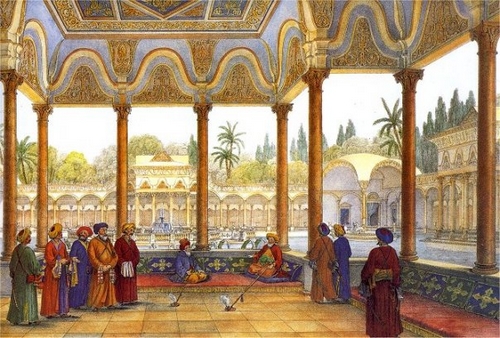
As it happened, Prince Saif was away from the Royal Palace most of the day. Badr, meanwhile, stayed at home; for it was not customary in those times for princesses to gallivant about the kingdom with their husbands, hunting leopard or swigging wine with Italian dignitaries.
Domestic confinement was just one of the ‘rules’ that Badr had to adhere to in her new life as wife of the Crown Prince. On the very night of their wedding, Saif had said to her, “Badr, my dear, now that we are here, in my country, and you are soon to be Queen, surely you have no more need of your Fairy wings?”
“Why? Why do you say that?” Badr had responded defensively. “I’m a Fairy, of course I need my wings!”
“I know, my love, I know. I just feel that it will be easier for you to, fit in here, if you don’t go around with those monstrous appendages on your back,” Saif had reasoned. “I mean, it unnerves people. Especially my mother! You know how jittery she gets in your presence.”
Seeing that Badr was recalcitrant, Saif had tried again, in his most conciliatory tones. “Look, all I’m asking is that you keep the wings away. Can you do that for me? Besides, you might get it into your head to fly to Paristan, or even Koh Kaaf one day! I can’t risk that now, can I?”
He had meant it as a joke, but Badr Jamal did not find the Prince’s comment remotely funny. It was as if to say that Saif did not trust her; that he considered her fickle, an unruly child who had to be disciplined and placated. However, she said nothing of this to him, and merely nodded. “Yes, of course, my Prince. Anything you say.”
And so, some months passed in this manner. While Saif was busy dispensing his princely duties, Badr would be attending balls and garden parties arranged by her mother-in-law the Queen, dressed in voluminous, human-style gowns, with her hair elaborately braided and coiffed in the human fashion, and her feet bound in jeweled sandals. She found these ladies’ functions excruciatingly boring – all they talked about was their children, their servants, the latest import of silks from China, the best way to prepare stuffed pigeon. Badr had no knowledge of these subjects, nor was she interested – she would have preferred to sing rather than talk, dance rather than walk, wear the least amount of layers the weather permitted, and let her hair fly loose in the wind. As for fancy foods, the meal she liked best was a hearty chunk of game venison (preferably raw), with a side of wild herbs, downed with good, strong grape liqueur.
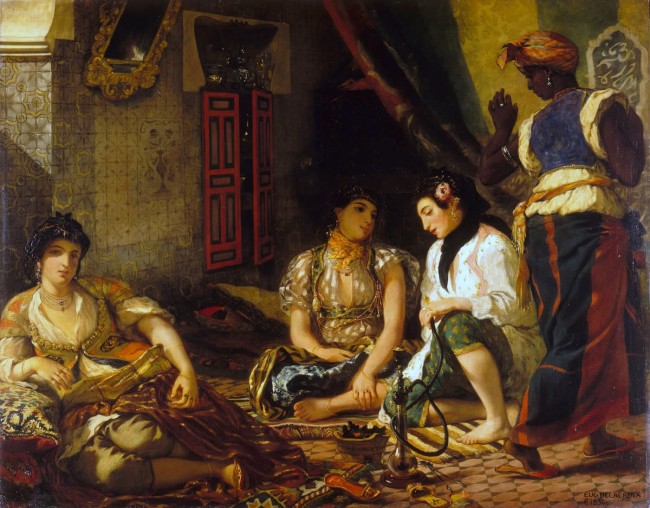
This predilection for bloody meat was another one of the Fairy Queen’s seemingly uncivilized idiosyncrasies that Saif was nervously learning about since their marriage. Yet another was bathing under the full moon in the nude, in the closest available water body – which meant the fountain in the central Palace courtyard. At this Saif had to put his foot down – his people were not ready, he said, to accept that kind of free-spirited behavior from their future Queen.
But the venison was an essential part of Badr’s natural diet. She could not do without it. Supplies were running low, and Saif was pressed to make an urgent trip to the southern woodlands to procure the next batch, under the guise of a sport hunting expedition. Venison was not commonly eaten in Egypt, and the Prince’s unplanned excursion would arouse suspicion if its true purpose was known.
While Saif was away, his uncle and aunt came to visit the Palace, along with their three daughters, Saif’s cousins. The family had been traveling in Asia for several months, and thus had missed the royal wedding. They came now to offer their presents and felicitations to the happy couple; and to see for themselves this mysterious Fairy that Saif had brought back with him from the Himalayas. The eldest of the three cousins, Safiyya, was particularly curious about Badr – you see, she had hoped to marry Saif herself one day. This young princess was exceptionally beautiful, not to mention exceedingly clever and proud to match. Deep in her heart, she could never forgive Saif for choosing another woman over her; or the other woman for taking what was rightfully hers.
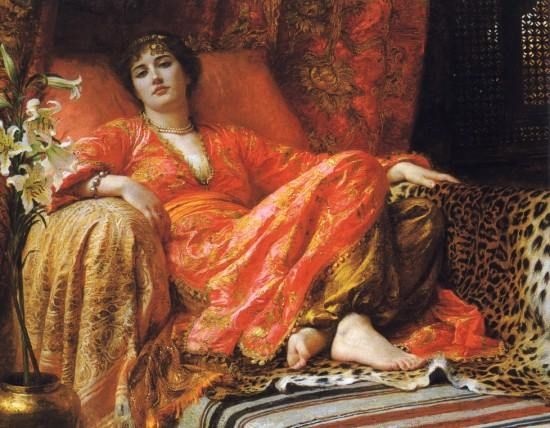
“My dear aunt,” Safiyya said to the Queen, Prince Saif’s mother, as she reclined on a divan in the zenana, the women’s quarters of the Palace. “Where are you hiding this Fairy daughter-in-law of yours? My heart is burning to see this piece of moonlight!”
Just at that moment, Badr entered the hall from a side door.
“I am Badr,” the Fairy announced. Safiyya, her sisters and mother quickly turned their heads towards the direction of the commanding voice, and saw standing before them a tall, plain-looking girl, her dull black hair tied back in a severe bun, and her face set into a grim line. Her skin was sallow, her eyes colorless and cold, and the rich robes she wore hung awkwardly over her thin frame. The contrast with Safiyya, who was petite and amply figured, with a rosy complexion, glossy brown curls, dark, mischievous eyes set in a heart-shaped face, and a vivacious laugh on her lips, could not have been greater.
“You?” Safiyya stared at Badr in disbelief. “You are the Fairy Queen Badr Jamal? Pardon my impertinence, Aunt,” she smirked, “but a milkmaid in a princess’s gown is a milkmaid nonetheless!” Everybody laughed, including the courtly ladies and servant girls present. “Love truly is blind, or Saif would never have picked this homely peasant girl over me!”
Badr’s cheeks flushed crimson, and the Queen looked visibly uncomfortable.
“Princess Safiyya,” Badr spoke in a restrained tone. “You are speaking in this ignorant fashion because you have not seen my true beauty yet.”
“Oh, is that so? There where is your true beauty?” Safiyya taunted. “Locked away in a trunk?” Again, everybody laughed, except Badr and the Queen.
“As a matter of fact, yes. It is locked away in a trunk,” Badr replied. “Queen Mother, if you please, bring me my wings.”
The Queen stuttered nervously. “Oh no, Badr, no, you know I can’t…You know Saif has forbidden you to…”
“It doesn’t matter what Saif has forbidden her to do or not,” Safiyya interjected. “He isn’t here right now. Aunt, please bring the wings, her ‘true beauty’ or whatever she calls them. Let us see what the fuss is about once and for all!”
The Queen had no choice but to comply. While she went to fetch the wings, word spread through the Palace that the Fairy Badr Jamal was about to demonstrate her flying ability. Nobody had ever seen a Fairy in flight before, and the excitement produced by this news was so great that by the time the Queen returned with the wings, folded and wrapped in layers of muslin, the women’s hall was packed. Everybody wanted to witness the spectacle of a flying Fairy.
“I don’t think this is a good idea, Safiyya,” the Queen whispered to her niece. “What if she flies away? What if she escapes?”
“How will she escape, aunt? We’ve bolted all the doors, barred all the windows. Besides, we don’t even know if she can fly at all!” Safiyya smirked again, confident in her triumphant beauty and full of ill will for Badr.
Badr stood on a raised platform at the end of the hall. The Queen handed her the parcel. She held it for a few moments, thoughtfully; then she spoke.
“Now listen to me, one an all!” The clamor in the hall dropped to a hushed murmur. “What you are about to see you have never seen before, and most likely will never see again. I don’t know how many of you can even withstand it. So let me say that I do not do this of my own will, but out of compulsion” – she shot an icy look at Safiyya – “to defend my own honor, as none here will do it for me.”
With that, Badr unwrapped the muslin parcel. The moment her fingers touched the misty, gauze-like material that lay folded inside, the dormant wings sprung to life; like a firecracker, they whizzed and whooshed through the air in circles before swiftly fastening themselves to Badr’s back.
What happened next is difficult to describe. The women and children who witnessed it could not stop raving about it till the end of their days; and the memory of what they saw has become the stuff of legend.
For, as soon as Badr’s wings attached themselves to her back, a blinding light burst forth from her person. The bulky dress she was wearing fell to the ground in a heap, the innumerable pins in her hair sprang out, her tight sandals came flying off.
And there she was, free, hovering above their dumbfounded faces in a dazzling halo of light. Her face glowed white like the moon, framed by clouds of black hair that shone like the midnight sky. Her golden eyes flashed with all the hues of the sun, and every movement of her long, slender limbs bespoke grace, as though she were swimming through the air, through the flowy, translucent garment that draped her body. And her wings – they were like living creatures in their own right, two iridescent chimeras filigreed with the brightest of silver, radiating all the colors of the universe.
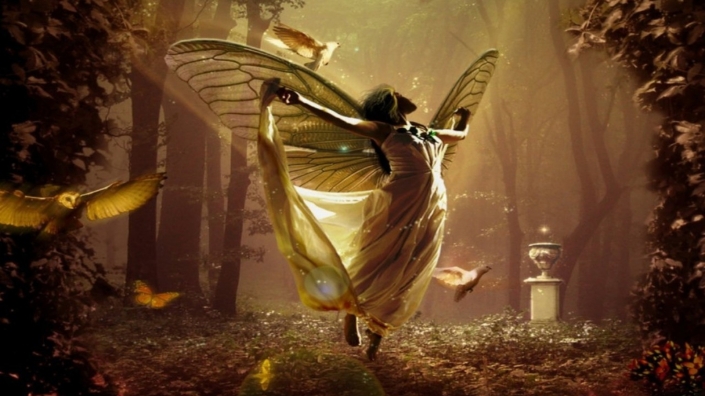
She was mesmerizing. She was unreal. She was the most beautiful sight that they had ever seen, and would ever see.
“Now, you all have seen me, in my true form, my true beauty.” Even Badr’s voice had changed. It was more powerful, more melodic. “But I know that you do not deserve me. Neither you, nor Prince Saif. You judged me for my beauty, my uniqueness, and bade me hide it; then you judged me for my lack of it.”
General commotion followed. There were shouts, and gasps, and people jostling each other to get closer to the Fairy Queen. But before anybody realized what was going on, Badr transformed herself into a white dove and flew straight out of the hall through a tiny crack in the roshandan, a small skylight in the corner of the ceiling that had somehow escaped attention. And just like that, she was gone.
Read Part VI of the story
This entry was posted in Adventure, Egypt, Fairies, Lakes, Legends, Magic, Mountains, Pakistan, Stories, Travel and tagged Badr, Egypt, Fairy, Folklore, Himalayas, Jamal, Kaghan, Koh Kaaf, Lake, Legend, Magic, Pakistan, Pari, Saif, Saif-ul-Malook, Silk Route.
The Legend of Saif-ul-Malook Part II

Lake Saif-ul-Malook, situated at a height 10, 600 feet at the northern tip of the Kaghan Valley in Pakistan’s Himalayas, is one of the most beautiful places on earth. I have been there twice, the first time as a 12-year old and then in 2009, when I determined to capture some of its magic on camera and on paper, in the words of two local storytellers who relate the legend of the Lake to visitors.
It is the story of a prince and a fairy, Saif-ul-Malook and Badr-ul-Jamal – a story of love, adventure, faith, magic, suffering and betrayal – a story of the multitude of human passions.
Many different versions exist, but below is a reproduction of what the storytellers told us, with ample writer’s liberties. I hope you enjoy it!
______________________________________________________________________________________________________________________________

It was the Lake – emerald-green, calm as a mirror, ringed by rugged snow-capped peaks – the very one from his dream.
Saif’s joy was uncontrollable. “I shall find her, I shall find her here!” he cried, jumping up and down like a child. “My suffering is finally over!”
In his excitement, he forgot about how he had been transported to the Lake in the first place – courtesy the jinn of Solomon’s cap, who was at this moment standing behind him in human form.
The jinn cleared his throat. “Ahem, Prince Saif…there is one thing.” Saif turned around with a start. “What…?” he said slowly, peering at the jinn.
“You will not be able to see the Fairy Queen Badr Jamal. She is, like us, naari, borne of fire, hence invisible to the human eye in her true form.”
“So, what must I do to see her?” Saif asked impatiently.
“You may pray,” the jinn replied. “Pray for forty consecutive days – the chilla – without food, drink or sleep, without moving from the circle wherein you sit. Then, and only then, will you be able to see the Fairy Badr Jamal.”
With these somber words, the jinn vanished.
It sounded impossible. Only saints and prophets like Jesus and Moses, and later on Baba Farid Ganj Shakkar and Hafiz of Shiraz, had been known to perform a chilla to completion – others either died or lost their senses in the attempt.
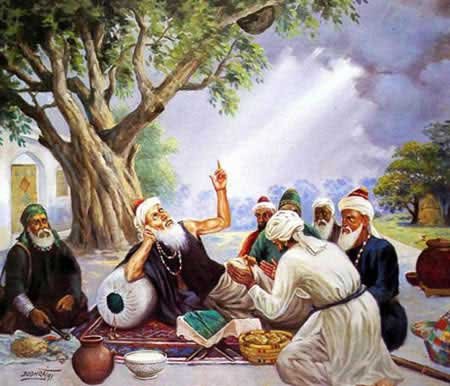
But Saif was not about to be thwarted from his objective so close to the end. “I’ve looked for her for six years, wandering the streets of Egypt with nothing but a kashkol, a begging bowl. Surely I can endure another forty days?”
So, drawing a circle of pebbles on the southern shore of the Lake, he seated himself inside, closed his eyes, and began to pray. He prayed, and prayed, and prayed, and as the suns went down and the moons came up, Saif grew a little weaker, his face thinner, his pain stronger, his yearning deeper. He lost count of the days, and awaited each night with the hope – “Perhaps I will see her tonight?”
But Badr Jamal did not appear.
One night, as the sun cast its dying amber rays on the Himalayan slopes, and twilight crept into the sky with the daub of a divine paintbrush, Prince Saif sat in his circle wondering if he would live to see another day. Physically exhausted, his body was about to give up the struggle, but his mind had never felt sharper, calmer.
It was also a chowdveen ki raat – the 14th of the lunar month, or night of a full moon – and the sight of that perfect silver orb, glowing in the star-studded indigo sky, enveloping the Lake, the mountains and himself in its ethereal light, filled Prince Saif’s heart with peace. “If I were to die here tonight, if my soul were to leave my body tonight, I would be happy man.”
Suddenly, a sound reached his ears – like the fluttering of a great flock of birds, far away at first, then closer – intermingled with a delicate tinkling, like the chime of a thousand tiny bells. Saif looked up; a great white cloud was moving from the west towards the Lake.

“Perhaps it’s the Angels of Death, come to take me home!”, Saif thought.
But they were not Angels, because Prince Saif-ul-Malook was not destined to die that night. That chowdveen ki raat, Saif became one of the handful of human beings to ever complete a chilla, and one of the rarer still to set eyes on the mythical Fairies of Koh Kaaf, the Caucasus Mountains, that magical land that lay at the border of Asia and the savage West. The Fairies flew to the Lake every full moon to bathe, and their Queen was Badr-ul-Jamal.
The white cloud slowly descended at the shore of the Lake, and seven forms emerged – seven beatific creatures, fair-limbed, dark-haired, golden-eyed, with large gossamer wings on their backs that glittered in the moonlight.
Saif was dumbstruck. An invisible force propelled him to his feet and he ran behind some large boulders, from where he could see without being seen. His mouth agape with wonder, he watched as the seven Fairies laughingly doffed their wings, folded them neatly on ground, and dived into the deep, shimmering waters of the Lake.
And then he saw her – Badr Jamal. She was the last to enter the Lake, effortlessly gliding through the water with her long black hair spread out behind her, her face radiant as the full moon, eyes twinkling like a child’s. She was the most beautiful creature he had ever set eyes on.
Prince Saif felt like he would faint from rapture. The object of his quest, of six years and forty days of tortuous struggle, was right there in plain sight; a living, breathing, palpable creature!

This entry was posted in Adventure, Lakes, Legends, Love, Magic, Mountains, Pakistan, Stories, Sufism, Travel, World and tagged Baba Farid, Badr, Caucasus, Chilla, Fairy, Folklore, Himalayas, Jamal, Kaghan, Koh Kaaf, Lake, Legend, Pakistan, Pari, Saif, Saif-ul-Malook, Silk Route, Story.